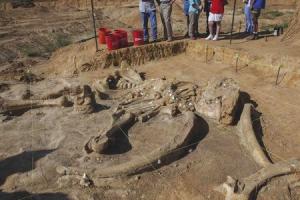This
clay facial reconstruction of Kennewick Man was carefully sculpted
around the morphological features of his skull, and lends a deeper
understanding of what he may have looked like nearly 9,000 years ago.
The
mysterious Kennewick Man, who died 9,000 years ago in the Columbia
River Valley, was a seal hunter who rambled far and wide with a
projectile point lodged in his hip, five broken ribs that never healed
properly, two small dents in his skull and a bum shoulder from the
repetitive stress of throwing spears.
He came from somewhere far
away, far up the Pacific Northwest coast, possibly Alaska or the
Aleutian Islands. He might even have come to North America all the way
from Asia.
That’s the argument of the editors of a new, 688-page, peer-reviewed book,
“Kennewick Man: The Scientific Investigation of an Ancient American Skeleton,” that will be published this fall by Texas A&M University Press.
Scientists
have told their story of Kennewick Man before in lectures and
interviews, but the new book represents the most detailed account of
research that came about only after scientists sued for access to the
bones. The Army of Corps of Engineers, which has custody of the bones,
had pressed the scientists to publish their research. Now it has finally
arrived, in a volume as thick and heavy as a textbook.
A
stone projectile point embedded in Kennewick Man’s right hip gave
researchers the first clue that he belonged to an ancient human
population; the spear point likely became lodged following an
adversarial encounter.
“Kennewick
Man could not have been a longtime resident of the area where he was
found, but instead lived most of his adult life somewhere along the
Northwest and North Pacific coast where marine mammals were readily
available,” the concluding chapter of the book states.
“He could
have been an Asian,” said co-editor Richard Jantz, emeritus professor
of anthropology at the University of Tennessee. “One of the things we
always tend to do is underestimate the mobility of early people.”
His
co-editor, Douglas Owsley, a forensic anthropologist at the
Smithsonian’s National Museum of Natural History, agrees with that
assessment of Kennewick Man: “He was a long-distance traveler.”
The
book, which includes contributions from more than five dozen authors,
researchers and photographers, describes many kinds of research on the
skeleton, which was discovered in 1996. The chemical analysis of the
molecular isotopes in the bones and the clues they provide to Kennewick
Man’s origin are likely to be among the most heavily debated findings.
The
analysis suggests that Kennewick Man lived off a diet of seals and
other large marine mammals and drank glacier-melt water. His wide-set
body is akin to what is generally seen in cold-adapted human
populations. The book includes a vintage photograph of an Inuit seal
hunter on an ice floe in Alaska — a suggested analog to Kennewick Man’s
lifestyle.
The
origin of Kennewick Man is relevant to the future disposition of his
bones. Native American tribes have claimed him as one of their ancestors
and have sought to rebury the remains in keeping with their customs.
The scientists argued that there is no evidence linking any of today’s
tribes to the skeleton.
They say that Kennewick Man’s skull,
which is large and narrow with a projecting face, doesn’t look like the
skulls of later Native Americans. This has been noted in other skulls
from that era, including that of a
teenage girl found in a submerged cave in Mexico, and the skull of a man found in the Channel Islands off the coast of California.
The
dimensions of Kennewick Man’s skull most closely match those of
Polynesians, specifically the inhabitants of the Chatham Islands, near
New Zealand, the scientists say.
He wasn’t himself a Polynesian,
however. Rather, according to the scientists, Kennewick Man and today’s
Polynesians, as well as the prehistoric Jomon people and contemporary
Ainu people of northern Japan, have a common ancestry among a coastal
Asian population.
These were hunters of marine creatures and
could have followed the edge of the ice around the northern rim of the
Pacific Ocean, harvesting seals and using primitive watercraft to travel
long distances, Owsley said.
“This is like a highway,” Owsley
said of the coastal route of migration. “People are going from the Old
World to the New World and back and forth.”
He said of Kennewick
Man, “His morphology is what people look like in the Upper Paleolithic
period along that whole circum-Pacific expanse.”
In
September 2014, researchers will publish a new book, “Kennewick Man:
The Scientific Investigation of an Ancient American Skeleton,” providing
the most thorough analysis of any Paleoamerican skeleton to date.
The heft of the volume and the
confidence of Owsley and his co-authors in their interpretation of
Kennewick Man is unlikely to end debate over who this ancient person was
and how he was related to other
Paleoamericans and Native Americans alive today.
The
Corps of Engineers has legal custody of the skeleton because it was
found on federal land. The Native American Graves Protection and
Repatriation Act requires that unearthed bones be returned to tribes for
reburial. But scientists sued to gain access to the bones, and a
federal court in 2004 ruled in their favor, saying NAGPRA did not apply
to Kennewick Man. Owsley said the scientists were allowed to study the
bones for 16 days in 2005 and 2006.
Gail Celmer, a regional
archeologist with the northwest division of the Corps of Engineers, said
the corps will review the book and “see if there’s anything in there
that changes how we’re curating the remains.”
She said she doubted it would end the debate over the bones.
“I don’t think it will ever settle the debate. People have different views about what NAGPRA actually is and how it’s defined.”
Two
teenagers sneaking into a boat race originally saw the bones and
notified authorities. The local coroner asked for assistance from a
forensic anthropologist, James Chatters, who at first thought, based on
the shape of the skull, that he was looking at the remains of an early
pioneer. But tests on the spear point indicated that these were
prehistoric remains.
Chatters excavated more than 300 bones, making Kennewick Man one of the most complete skeletons from that era.
In
the legal fight, the scientists won the right to do a limited amount of
research, starting in 2005, but until now they have not presented their
full findings.
Three of the papers list Chatters as an author,
but he does not sign on to the view that Kennewick Man came from
somewhere far away.
“If
he’s an eater of seals, he’s in the wrong position,” Chatters said. He
said Kennewick Man is more than 100 miles from the nearest seal.
He also believes the spear point in his hip comes from somewhere not too far away.
“It’s a serrated edge, leaf-shaped point, of a style known as a Cascade point,” Chatters said.
Owsley said he and Chatters have agreed to disagree on some of these issues.
The
ramblin’ man hypothesis will be viewed as a boost for the controversial
idea that the Americas were peopled in multiple migrations by disparate
populations — some moving on foot, some rowing or paddling along the
coast.
The more orthodox view is that people from northeast Asia
walked to the Americas during the Ice Age when sea levels were so low
that the Bering Strait was dry land. Genetic evidence points to a common
ancestry among Native Americans to a population that remained isolated
for a long period of time in the now-drowned land known as Beringia, and
that then migrated, possibly in several pulses, after the ice sheets
covering much of North America began to recede and an ice-free corridor
opened in the center of the continent.
Deborah A. Bolnick, an
anthropological geneticist at the University of Texas, said that all
Native Americans studied so far show markers, in their mitochondrial
DNA, of a common ancestry with people who lived in Beringia. She said it
is therefore reasonable to suppose that Kennewick Man is also descended
from that population.
Genetic testing on Kennewick Man is being
conducted in Denmark, and those results are eagerly awaited and could
alter the scientific narrative yet again.
One
issue that remains fuzzy is Kennewick Man’s age at his death. Owsley
said he appeared to be about 40, but further testing, if permitted,
would help pin that down. He argues that scientists should have further
access to the skeleton, which for now is held in the Burke Museum at the
University of Washington.
“I’m trying to honestly ensure that
another generation of scientists has the opportunity to study this
skeleton. They’re going to have technology that we don’t have,” Owsley
said in an interview.
And there will always be additional questions. Did he have a mate? Children? A clan?
Chatters said he probably lived in a band of 20 to 40 people.
And
he surely was a strong man, able to endure pain from myriad injuries
and the challenges of life as a hunter, Chatters said. His survival from
a serious injury — the embedded spear point in hip — seems to suggest
something.
“He was injured severely enough when he was young that somebody took very good care of him,” Chatters said.





 I
loved back-to-school time when I was a kid. I got new penny loafers, a
plaid skirt, and knee socks. We never started school before September.
But I didn’t look forward to the beans and cornbread the cafeteria
served at least twice a week. Things have changed quite a bit since
then. A post at Wide Lawns and Narrow Minds contrasts the process of
sending kids to school when the author was a kid with the process today.
For example, packing lunches.
I
loved back-to-school time when I was a kid. I got new penny loafers, a
plaid skirt, and knee socks. We never started school before September.
But I didn’t look forward to the beans and cornbread the cafeteria
served at least twice a week. Things have changed quite a bit since
then. A post at Wide Lawns and Narrow Minds contrasts the process of
sending kids to school when the author was a kid with the process today.
For example, packing lunches.




 Well,
his heart was in the right place. Jesean Morris wanted to help ALS fund
research to cure amyotrophic lateral sclerosis. So he took the ice
bucket challenge and posted the video on Facebook to spread awareness
about the cause.
Well,
his heart was in the right place. Jesean Morris wanted to help ALS fund
research to cure amyotrophic lateral sclerosis. So he took the ice
bucket challenge and posted the video on Facebook to spread awareness
about the cause.
























